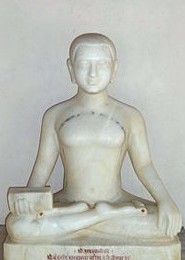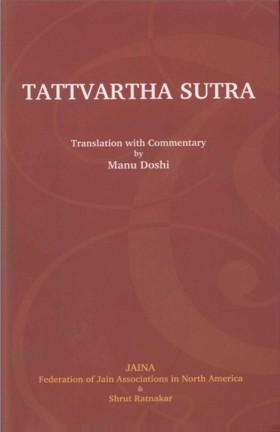05.01 Ajeevakāyā Dharmādharmākāshpudgalāh
Audio: Sanskrit: अजीवकाया धर्माधर्माकाशपुद्गला: ।
Hindi: धर्मास्तिकाया, अधर्मास्तिकाया, आकाशास्तिकाया और पुद्गलास्तिकाया ये चार अजीवकाय है।
05.02 Dravyāni Jeevāshcha
Audio: Sanskrit: द्रव्याणि जीवाश्च ।
Hindi: धर्मास्तिकाय आदि चार अजीव तत्त्व और जीव ये पांच द्रव्य है।
05.01-02
English: These sutras state that Dharma, Adharma, Ākāsh and Pudgal together with Jeev are the five basic substances. The statement presents certain terms, which are not well known, but are very vital for comprehending the Jain philosophy. Of four substances mentioned in the first sutra, Ākāsh stands for space and that is self-explanatory. The remaining three substances are explained below.
Dharma and Adharma: Dharma is normally understood as religion and Adharma as irreligious activity. Those terms are, however, used here in different sense and do not have religious or irreligious connotation. They denote two ether-like invisible substances, which are supposed to exist in the entire universe.
The question may then arise, 'Why do we need to believe in such abstract concepts particularly when other theologies do not admit their existence?' The reply is that Jeev and Pudgal have the capability to make movement, but they cannot exercise that capability in absence of some medium. This can be explained by an example. A fish is imbibed with the capability to swim, but it cannot exercise that capability in absence of water; it needs the medium of water to exercise its capability to swim. Similarly, Jeev and Pudgal cannot exercise their capability to move without some medium. Jaintsm calls that medium as Dharma.
The existence of Adharma has also to be admitted on similar ground. Capability to move also implies the capability to remain steady. In absence of that capability, a mobile object would continue to move forever. Some different medium is therefore necessary particularly to pudgal for remaining steady.
Jainism calls that medium as Adharma. But Dharma and Adharma are not supposed to help in making movement or in remaining steady. Jeev and Pudgal are inherently imbibed with such capabilities and they can exercise the same on their own. Dharma and Adharma are merely instrumental in enabling them to exercise those capabilities.
Pudgal denotes all the tangible objects, whether visible or invisible. The term is made up of Pud meaning supplementing and Gal meaning dropping off or draining out. As such, the matter, which is subject to influx and reñux or which can aggregate and disaggregate is Pudgal. Whatever can be seen with eyes or be known by any other organ is Pudgal. Other theologies term it as Prakrti, Maya, etc.
 Acharya Umaswati
Acharya Umaswati
